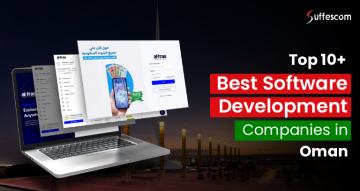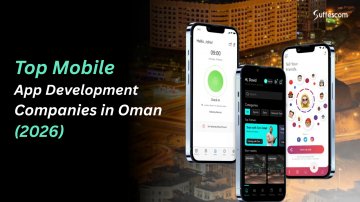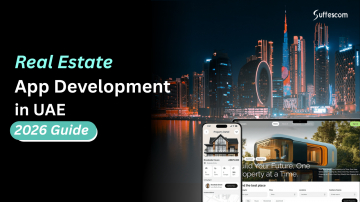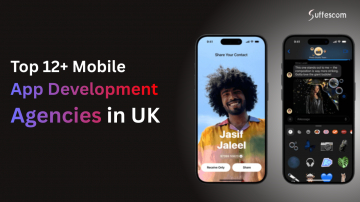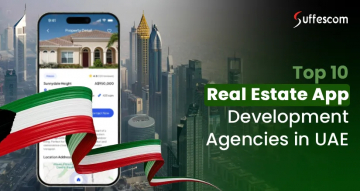Develop Shopping App Like OUNASS: Business Model, Features & Cost
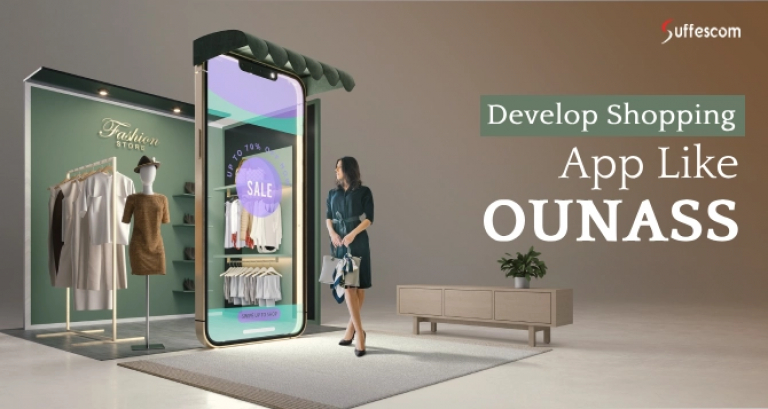
The Rise of Luxury E-Commerce in the Middle East
The Middle East’s luxury retail landscape has been experiencing a massive transformation. It is moving from lavish in-store experiences to high-end online platforms. Over the past decade, the growth of premium products has been closely tied to the region’s increasing digital adoption. From fashion and jewelry to bespoke beauty products and high-end home decor, e-commerce platforms are offering the same exclusivity once reserved for luxury boutiques.
According to IMARC Group, the market is expected to reach USD 2,020.6 billion by 2033, growing with a CAGR of 15.3% from 2025 to 2033. The rapid digitalization is accelerating consumer confidence with online transactions. Along with the rising urbanization and changing lifestyles, economic diversification is one of the key factors driving the market. In this blog, we’ll explore how the GCC retail industry is evolving, what’s fueling mobile commerce growth, the rise of high-net-worth individuals, and why platforms like OUNASS are redefining luxury shopping in the region.
The Transformation of the GCC Retail Industry
The Gulf Cooperation Council region incorporates the UAE, Saudi Arabia, Qatar, Kuwait, Bahrain, and Oman. This has been considered a hub for luxury retail, and a strong culture of status-led consumption. However, recent years have seen a massive growth towards digital commerce.
Key changes driving this transformation include:
Higher smartphone penetration: It is one of the highest rates in the world, with 2024, more than 97% of the UAE's population owning a smartphone.
Natively born consumer base: Webrooming is the number one preference for digitally literate shoppers in the GCC, where approximately 60% of the population is aged below 30.
Changing lifestyle trends: Post-pandemic trends are assisting in transforming global digital trends, making consumers more receptive to e-commerce for luxury products.
Growth statistics on mobile commerce and high-net-worth individuals
Two factors are driving luxury e-commerce growth in the Middle East. First, mobile shopping is booming. Elsewhere, in the UAE, over 80% of luxury purchases occur through smartphones, and Saudi Arabia’s market is expected to surpass approximately $20 billion by 2025. Additionally, the number of high-net-worth individuals is increasing rapidly. The UAE alone saw a 15.5% jump in millionaires last year, while Saudi Arabia ranks among the top 20 globally for ultra-rich residents. According to the Chalhoub Group, luxury e-commerce now accounts for around 13% of the GCC personal luxury market, growing faster than global averages. This wealthy, mobile-first crowd is gaining demand for faster and seamless luxury shopping experiences online.
Why OUNASS Stands Out?
OUNASS has carved a unique space in the Middle East’s luxury e-commerce market by offering not just premium products but a shopping experience tailored to the region’s lifestyle and expectations.
Here’s what makes them different:
Premium Brands & Curated Collections:
OUNASS doesn’t believe in clutter. The platform includes a wide selection of international designers, regional labels, and exclusive collections. Whether it’s a Ramadan , a vacation wardrobe, or the latest in designer footwear, everything feels carefully picked for the local market.
Fast, Hyperlocal Delivery:
Speed matters most, and OUNASS delivers. With 2-hour delivery in Dubai and Kuwait, 3-hour service in Riyadh, and same-day options across the UAE, it’s one of the fastest luxury delivery services in the region. It is considered perfect for last-minute event looks or gifting emergencies.
Designed for Middle Eastern Shoppers:
Unlike generic global platforms, OUNASS genuinely understands the region’s fashion tastes and cultural preferences. From modest evening wear to bold statement pieces, the product range suits the lifestyle and fashion preferences of its local audience.
Human-Centric Service:
OUNASS adds thoughtful touches, including personal stylists, exclusive member offers, and curated recommendations. It is totally based on style, making online luxury feel personal, not transactional.
Purpose of This Guide
The luxury e-commerce market in the Middle East is growing fast, and platforms like OUNASS have set a high standard for what premium digital shopping should feel like. This guide is designed to help startups and businesses understand what it takes to build a similar app that isn’t just functional, but also tailored to the expectations of high-end shoppers.
We’ll break down everything you need to consider:
- The business strategy behind launching a premium platform
- The technology choices that power smooth, fast, and secure online shopping
- How to craft a user experience (UX) that feels personal and luxurious
- And most importantly, a clear look at the cost factors involved in developing a luxury e-commerce app for markets like the UAE, Saudi Arabia, and beyond.
Develop a Shopping App Like Ounass
Ready to launch the next luxury shopping experience? Start building your Ounass-like app today!
Understanding the OUNASS Business Model
OUNASS runs as a premium-only platform offering curated luxury fashion. It earns through commissions, featured brand placements, and exclusive drops. With fast delivery and selective partnerships, it focuses on high-end shoppers in the GCC. The model blends exclusivity, speed, and service to meet luxury market expectations.
Core Business Strategy
OUNASS has built its success on a clear and focused business approach tailored to the Middle East’s luxury shoppers. Here’s how it works:
Premium-Only Marketplace:
OUNASS features only luxury and designer brands, avoiding mass-market labels to maintain an exclusive, high-end shopping experience.
Curated Brand Control:
The platform handpicks which brands and collections appear on the site, ensuring every product matches local style preferences and luxury standards.
Exclusive Online Drops:
To keep things fresh and exciting, OUNASS regularly launches limited-edition collections and exclusive product drops available only on their platform.
Revenue Streams
Now, let’s talk about how they actually make money. It’s not just from selling products. OUNASS has several smart ways to generate revenue, and here’s how it works.
Commission per sale
Get commission on every sale made through their platform. It's pretty straightforward: when a customer buys something, OUNASS gets a cut of that transaction.
Featured brand placements
Next, there’s the option for featured brand placements. Luxury brands can pay to be highlighted on the homepage or featured in special campaigns. It helps to make the brand unique in a crowded market.
Exclusive collection sales
It is considered the biggest money-making strategy which is exclusive collection sales. Because these limited drops aren’t available anywhere else, OUNASS can secure better profit margins through special deals with brands.
Shipping charges
Finally, while many orders come with free delivery, there’s an extra charge for express or international shipping. It might sound small, but when you’re selling high-ticket luxury items, even shipping upgrades can add up to a decent revenue stream.
Target Audience and Market Position
OUNASS has a clear focus when it comes to the audience. The platform caters to successful shoppers across the GCC, with a strong emphasis on women aged 25 to 45. The customers are tech-savvy and luxury-driven, always searching for premium brands and exclusive pieces. They value fast delivery, convenience, and a personalized touch, all things OUNASS makes sure to deliver.
Key Partnerships and Brand Curation
OUNASS works with more than 600 luxury brands, including favourites such as Gucci, Balenciaga, Valentino, and Saint Laurent. But it’s not just about listing famous labels. The in-house team carefully selects every collection, curating pieces that suit the region’s style and seasonal trends. It helps to keeps the platform secure, relevant, and reliable with what local shoppers want.
Market Research & Competitor Analysis
A look at where OUNASS stands in the GCC luxury market that understands shopper trends, key competitors, and what sets the brand apart in a fast-growing digital fashion space.
Major Competitors in the MENA Region
Middle Eastern luxury e-commerce is becoming congested, with some robust brands emerging:
Namshi (GCC): Its rapid collections of fast fashion and extensive product assortment make Namshi attractive to consumers seeking on-trend, value-driven options alongside niche premium brands.
Farfetch (Global/GCC): It is a global player with a strong presence within the GCC. Farfetch provides global delivery and collaborate directly with independent boutique partners. It allows consumers to get their hands on elusive designer items.
The Luxury Closet (UAE): This site specializes in the luxury resale space, providing authenticated, pre-owned designer goods. It's favoured by consumers who desire high-fashion at more affordable prices, augmented by a secure authentication procedure.
Trends in Luxury Online Shopping
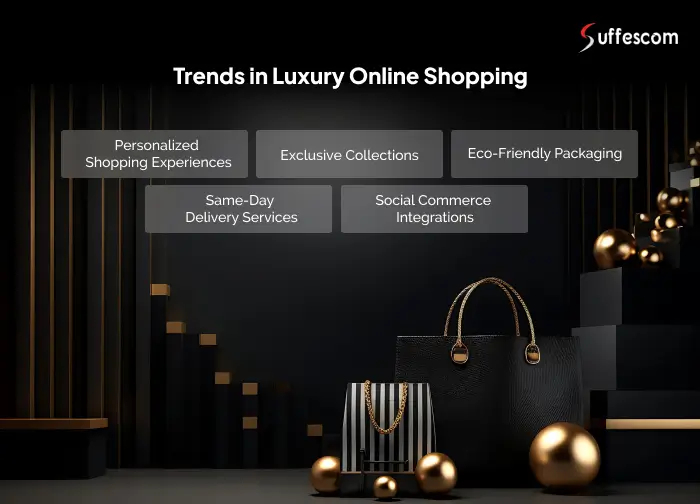
The online luxury scene in the Middle East is changing so fast. Here’s a look at the key trends shaping how people shop for high-end products online:
Personalized Shopping Experiences
Luxury shoppers expect a bit extra, thus brands are stepping up. More online platforms are providing customized recommendations that are based on browsing habits and past purchases. Alongside that, AR try-on tools for accessories, sunglasses, and beauty products are becoming increasingly popular, enabling customers to preview how items look before making a purchase.
Exclusive collections
Limited collections have been around, but online exclusivity is what's popularizing them. Websites are now releasing capsule collections that are only online for a limited time, which creates buzz and gets customers coming back for what's new and limited.
Eco-Friendly Packaging
Shoppers are very interested in something beyond the label. There is increasing enthusiasm for brands that have sustainable collections and environmentally friendly packaging. Most luxury platforms now feature items produced from sourced materials or promote ethical processes.
Same-Day Delivery Services:
Quick delivery is the basic expectation of consumers. It is especially in cities such as Dubai, Riyadh, and Abu Dhabi. Shoppers prefer platforms that deliver high-value purchases within a few hours. It’s not only about speed, managing convenience and reliability is also crucial.
Social Commerce Integrations:
Luxury shopping isn’t limited to websites anymore. Instagram , TikTok product tags, and influencer-led live shopping sessions also becomes a part of buying journey. Shoppers, especially younger, mobile-first customers, explore social media for new styling ideas and make direct purchases without leaving the app.
Consumer Behavior Insights
- 60% of high-value customers now prefer shopping on their phones over desktops. It’s quicker, more convenient, as people love the convenience of quick, mobile-first platforms.
- Around 70% check Instagram for style ideas and brand updates before making a purchase. Social media isn’t just for browsing anymore. It’s a part of the luxury buying journey.
Essential Features of a Shopping App Like OUNASS
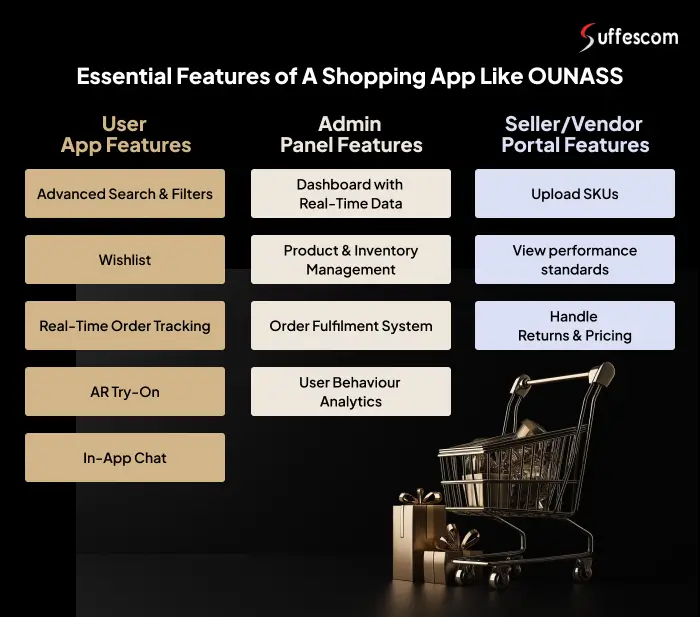
While building a luxury shopping app for GCC market, it’s about creating a seamless, personalized, and reliable shopping experience. Below are the essential features that every e-commerce platform should offer to fulfill rising customer expectations.
User App Features
These features make sure people can shop smoothly, track their orders, and get the help they need without any hassle:
Advanced Search & Filters:
Allow users to narrow down products by size, color, price, and category. It makes product discovery smooth and hassle-free. With numerous luxury products on offer, shoppers find a simple way to grab what they’re looking for. Thus, advanced search tools and detailed filters come in to find their products easily.
Wishlist:
Not a single purchase happens instantly, especially when it comes to luxury goods. A wishlist feature enables users to save their favorite products to revisit later. Whether the shopper waiting for payday, any special occasion, or drop in the price. It’s a small detail, but one that keeps shoppers connected to the app.
Real-Time Order Tracking:
Provide customers an instant updates regarding the location and status of orders as they move through the delivery process. It adds peace of mind and improves post-purchase satisfaction, and reduces the need for follow-up calls or emails.
AR Try-On:
Buying fashion or accessories online can be tricky without knowing how they’ll look on you. Thus, many luxury apps are adding AR-powered try-on tools. It enables users to virtually test out sunglasses, lipstick shades, or handbags, making them feel more confident about their purchase.
In-App Chat:
Luxury shoppers often expect customized assistance, and an in-app chat offers the same. It connects customers directly to a support team, providing product suggestions, size guidance, and help with orders, right when it’s needed.
Admin Panel Features
Every luxury shopping app is considered a control panel that keeps operations running smoothly. These admin-side features help manage everything from inventory to customer behavior.
Dashboard with Real-Time Data:
An intuitive and user-friendly dashboard offers business owners a live overview of purchasing orders, sales, stock levels, and control over user activities. Helping in tracking performance, detecting issues early, and making customer feedback better.
Product & Inventory Management:
It enables admins to add new products, update descriptions, adjust stock levels, add size, colour, or material options, and manage product visibility items without hassle. The collection of product changes with seasons and trends, opt for a system that makes updating listings simple.
Order Fulfilment System:
Once orders start coming in, efficient processing is a must. This tool manages everything from taking orders to packaging and allocating them for delivery. To ensure customer satisfaction, it guarantees timely order delivery.
User Behaviour Analytics:
Knowing how customers interact with your app helps you improve it. User analytics track peak browsing hours, search patterns, time spent on pages, and purchase trends. It can be used to fine-tune product recommendations, which keeps the app updated.
Seller/Vendor Portal Features
The app enables third-party vendors or boutiques to list their products, providing them with tools to keep their businesses running smoothly.
Upload SKUs:
With ease, vendors can list their products by uploading SKUs, descriptions, images, prices, and stocks. This maintains their collections current and allows new arrivals to be listed without delay.
View performance standards
Each vendor has access to a customized dashboard that showcases real-time sales, top-selling items, reviews, and stock status. It helps to monitor performance and make smart decisions regarding prices and stock management.
Handle Returns & Pricing:
Allow vendors to manage returns and pricing with ease. They can approve or reject returns, issue refunds, and alter product pricing whenever feels crucial to stay competitive in the demanding market.
UI/UX Design Considerations
When it comes to luxury e-commerce apps, Of course, looks matter. A good design doesn’t just showcase products; it makes shopping easy, clean, and enjoyable. Let’s look at what that involves.
Luxury Visual Identity
A luxury app should look premium the moment it opens. It includes the best brands that stick with serif fonts, clean white space, and soft, muted color palettes. The elements make the application simple, user-friendly and grab the attention of users.
Micro-Interactions & Animations
Little details help in making the luxurious UX of an application. Hover animations on product images or buttons make browsing through images or switching between pages. It makes the experience feel polished and effortless. Helps in improving user engagement and keeps shoppers browsing for longer without even realising it.
Tech Stack Behind a Luxury Shopping App
Choosing the right tools and technologies isn’t just about performance. It is about what keeps the app fast, secure, and smooth for every shopper, every time.
Frontend: Flutter / React Native / Swift / Kotlin
Backend: Node.js / Django / Laravel
Database: PostgreSQL / MongoDB
Hosting: AWS / Google Cloud
Payments: Stripe, PayTabs, Apple Pay, Mada (KSA), Tabby
Push Notifications & Messaging: Firebase Cloud Messaging (FCM), Pusher
Content Delivery Network (CDN): Cloudflare, Fastly
AI and Recommendation Systems
Luxury shoppers expect their apps to feel personal. It includes features such as smart recommendation systems, personalized product feeds, and helpful search suggestions. These tools quietly work in the background, allowing users to like and suggesting products that match their style.
One popular method is collaborative filtering that boosts personalized product feeds. Similar users have browsed and recommended items you might like too. It keeps the shopping experience fresh and customized, engaging customers to discover products on their own.
It's another smart touch, utilising Natural Language Processing for search auto-complete. This means when a shopper starts typing a brand, product, or category, the app instantly suggests relevant, brilliant results based on what’s trending or previously searched. It makes finding products faster and reduces the chance of spelling errors or missed searches.
Shopping App Development Process
Building a luxury shopping app isn’t something you finish overnight. It needs a proper plan, good design, and careful testing. Let’s go through it step by step.
Discovery & Planning
First, you need to understand your market. This means doing some research. Find out what shoppers want. See what your competitors are already offering. Without this, you're just guessing.
Then comes feature planning. You can't build everything at once. So, list out all your app ideas and decide which ones are most important. This is called feature prioritization. Focus on what’s necessary for your MVP (Minimum Viable Product). In other words, determine what you need to launch quickly and reserve the extras for later.
Prototyping and Wireframes
Once you have a plan, it’s time to design. Start with basic layouts, also known as wireframes. Tools like Figma or Adobe XD work well for this.
These are simple sketches of your app’s screens. They show where things are located and how users navigate. It’s better to fix problems here than after development begins.
Agile Development Phases
After the designs are approved, coding kicks off. Most teams use the Agile method. It will break big tasks into small parts called sprints.
Each sprint usually lasts two weeks. During this time, developers develop a unique set of functionalities. They build it, test it, and move on to the next. It keeps things organized and avoids last-minute delays.
Testing & QA
Finally, the app needs testing. It includes both manual testing and automated tests through tools such as Appium and Selenium.
But that’s not enough. You need to test on real devices. Different phones and tablets behave differently. Testing on actual devices makes the app run smoother, whether using an iPhone or an old Android.
Cost of Developing an Shopping App Like OUNASS
So, how much does it really cost to build a luxury shopping app like OUNASS? Well, there’s no one-size-fits-all answer — it depends on a few key factors.
Firstly, the number of features plays a significant role. A basic version with standard eCommerce features (like product listings, checkout, and user accounts) will cost a lot less than one packed with personal stylists, AR try-ons, and regional payment options. Apart from that, think about the design complexity. Luxury apps should look elegant and smooth. Thus, investing in top-tier UI/UX design reflects the brand's personality.
Cost Breakdown by Region
| Region | Average Cost/hour | Approx. Total Cost (USD) |
| US/UK | $80–$150 | $200,000–$400,000 |
| Eastern Europe | $30–$60 | $100,000–$150,000 |
| Middle East | $20–$40 | $50,000–$100,000 |
Time Estimate per Module
It gives a clear idea of how long each feature will take to build:
| Module | Est. Hours |
| UI/UX Design | 120–160 |
| Frontend (Mobile) | 400–600 |
| Backend & API Dev | 300–500 |
| Testing & QA | 100–150 |
In-House vs Outsourced Development
While creating an application like OUNASS, one of the first big decisions is whether to hire an in-house team or outsource the development. Both have their pros and a few trade-offs.
Adapting in-house team is more beneficial as it gives you more control. Work closely with your team, maintain a consistent brand voice, and adapt to changes as you progress. It usually comes at a higher cost, especially if you’re hiring full-time designers, developers, and testers.
Post-Launch Maintenance Cost
Once your app is live, work does not stop here. You’ll need to keep things running smoothly, fixing the bugs, and updates over time. This is where post-launch maintenance comes in.
Depending on how many users you have and add new features you add monthly. Costs can range from $2,000 to $10,000. It really comes to checking how shoppers handling the things and how often you want to improve it.
Monetization Strategies
Once your app is up and running, the next question is: how do you actually make money from it. Let’s break down a few simple ways that luxury E-commerce platforms bring in revenue without overloading the user experience.
Subscription Model
Some shoppers are happy to pay a little extra, especially if it means getting something special in return. That’s why offering a VIP membership makes sense.
Give members early access to exclusive sales, priority delivery, or even personal styling perks. It’s a great way to reward loyal users and develop a steady income stream simultaneously.
Affiliate & Influencer Integration
Let’s be honest, most people discover products on social media now. Avoiding influencer partnerships means you’re probably leaving money on the table.
By giving creators referral codes or trackable links, you can easily reward them for any sales they help generate. It’s simple, and it works especially in fashion and luxury, where people trust real style recommendations.
Loyalty Programs & Sales
You don’t have to run deep discounts all the time, but occasional seasonal sales help drive buzz. Pair that with a loyalty program, and you’ve got something customers will come back for.
Think points for purchases, member-only offers, or even just a small reward on their birthday. These things go a long way and they help build trust and repeat business over time.
Challenges in Building a Luxury E-Commerce App
Building a luxury shopping app isn't just about putting products online. It’s about offering an experience. It comes with a unique set of challenges. It is especially when you're dealing with high-end customers who expect nothing less than perfect.
Managing Logistics for Premium Brands - Luxury customers don’t want to wait, and they definitely don’t want a wrinkled package dropped at the gate. That’s why logistics is a big deal.
You’ll need to figure out same-day or even two-hour delivery options, especially in regions like the UAE or Saudi Arabia, where quick fulfilment is the norm. And it’s not just about speed — the delivery itself has to feel premium. Think white-glove service, branded packaging, and careful handling of high-value items.
Meeting High Customer Service Expectations - Support isn’t just about solving issues it’s part of the brand experience. Luxury shoppers expect someone to be available when they need help, no matter the time or language.
It means that providing 24/7 customer support works ideally with multilingual agents. On top of that, extra features such as like gift wrapping, handwritten notes, or even a personal stylist that can make a lasting impression.
Handling Returns & Refunds Gracefully - Even luxury customers return things, but how you handle it can make or break loyalty. In this space, a slow or rigid return process just won’t cut it.
Instead, consider the pick-up for returns, along with hassle-free exchanges or instant refunds. It may cost a little more, but it develops long-term trust with customers by appreciating service.
Future Trends in Fashion E-Commerce Apps
The luxury fashion space keeps changing and fast. The things that worked a year ago might not impress today’s digital shoppers. That’s why businesses in this space need to stay one step ahead. Let’s walk through a few trends that are already shaping the next phase of premium fashion apps.
Blockchain for Authenticity
Let’s start with trust; it’s everything. High-end customers really want to know their purchase is 100% authentic. That’s why more brands are shifting towards blockchain to verify that shoppers buy is the real deal.
With smart tags and digital certificates, customers can examine a product and instantly see where it came from, whether it’s original or not. It’s about building long-term confidence in your brand.
AI Stylists & Smarter Recommendations
Customers want proper guidance where AI-powered tools are starting to play a bigger role. Instead of using basic filters, shoppers expect apps to understand and suggest full looks that make sense.
Virtual stylists and AI-based outfit builders offer support. These tools analyze past purchases, browsing behavior, and even current fashion trends to recommend entire outfits, not just one-off items. This leads to better engagement and often higher average order values.
Smart Mirrors & IoT Integration
Finally, let’s talk about the “wow factor.” As more shopping occurs from home, the physical retail experience is being reimagined, and smart mirrors are a key part of that evolution.
By connecting to AR tools and IoT devices, luxury apps can now let users “try on” clothing virtually, see how something fits, or even preview styles in their own space. It brings the dressing room to them and makes the online journey feel more real, more personal.
Build Your Own App Like OUNASS Today!
Suffescom is the best app development company for getting Ounass like app develop , We have 250+ expert team of developers who had worked for big giants of middle east
FAQ's-
1. How much does it cost to develop an app like OUNASS?
The cost starts from $50,000 to $300,000. It depends on the functionalities, the region you're building in, and the technology stack you select. The more polished and scalable an application is, the more budget you'll need to create it.
2. What makes OUNASS different from other e-commerce apps?
OUNASS is not an average shopping app. It’s a luxury application providing systematized collections from top-tier brands. Its 2-hour delivery makes it apart as that speed and exclusivity isn’t easy to match.
3. Which region is best for launching a luxury shopping app?
The GCC region, especially app development company from UAE and Saudi Arabia, is ideal. These countries have a high number of affluent, mobile-first shoppers who are comfortable spending online, especially when it comes to premium fashion.
4. Can AR/VR be integrated affordably?
Yes, absolutely. You don’t have to break the bank. With open-source libraries like 8thWall or Vuforia, you can add AR features (such as virtual try-on) for approximately $5,000 to $10,000, depending on the level of advancement you desire.
5. What tech stack does a luxury app need?
Most modern luxury apps are built using frameworks such as Flutter or React Native for the frontend, Node.js for the backend, and PostgreSQL as the database. Instead, these are hosted on platforms like AWS or Google Cloud. This tech stack gives flexibility and good performance to the application.
6. How long does development take?
On an average basis, it takes 4 to 9 months to build a fully working app. It includes market research, wireframing, UI/UX design, backend setup, and post-launch revisions. To build a complex application OUNASS, you’ll want to plan for a longer timeline to get everything just right.
7. How to attract high-end brands to list on your platform?
Focus on curated exposure and align with their brand values. Show that your platform targets the right audience, offers premium marketing packages, and builds customer trust through quality UX, fast delivery, and verified sellers. Brands want visibility, but they also want control over presentation.
8. What are the legal considerations for fashion e-commerce in UAE?
You’ll need to take care of a few basics, like VAT registration, e-payment licensing, and import/export clearance. Make sure your business complies with UAE’s e-commerce and fashion retail laws. It’s not too complicated, but worth getting expert help early on.
9. Should you go with a native or hybrid app?
If you want top-notch performance and a truly polished feel (which luxury users expect), go for a native app. But if you’re testing the waters with an MVP, a hybrid app can save time and budget.
10. What are the key performance KPIs post-launch?
Once your app is live, keep an eye on metrics such as conversion rate, average order value, customer acquisition cost (CAC), retention rate, and even the app uninstall rate. It tells what is working or what's not.
11. Can I launch a web app before mobile?
You can, but in this space, it’s not always the best idea. Luxury shoppers in the GCC mostly shop on mobile, so building a mobile-first experience is usually smarter. If you must start with web, keep the mobile version close behind.
12. What is the best marketing strategy for a luxury shopping app?
Focus on influencer marketing and exclusive drops. Partner with micro-celebrities who reflect brand’s style, and their followers often trust their picks. Also, run Instagram ads targeting high-income, fashion-savvy users to drive the right traffic and build brand buzz.

